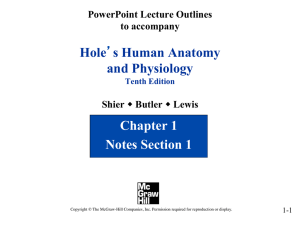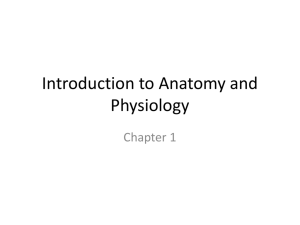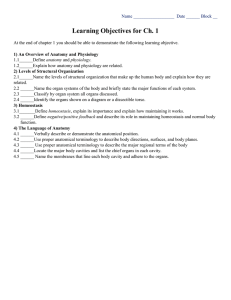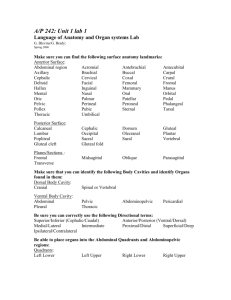Hole’s Human Anatomy and Physiology Chapter 1 Notes Section 1
advertisement
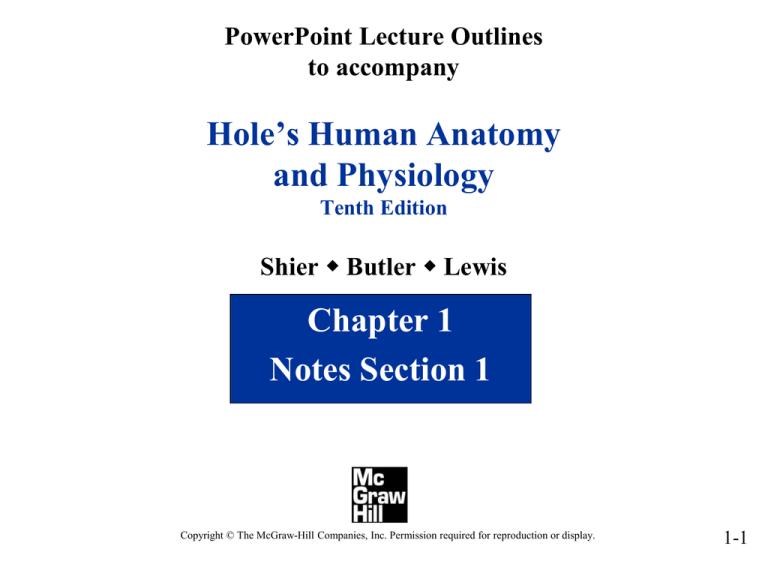
PowerPoint Lecture Outlines to accompany Hole’s Human Anatomy and Physiology Tenth Edition Shier w Butler w Lewis Chapter 1 Notes Section 1 Copyright © The McGraw-Hill Companies, Inc. Permission required for reproduction or display. 1-1 Biology II Introduction Scientific Method Steps of the Scientific Method * * *Experimental Design/Data Collection ___________________the Hypothesis This can also be ___________or_____________ *Analysis (Explaining the Data) Scientific Method Terms Control The factor in an experiment that _______________________throughout the course of the experiment. All good experiments have at _____________________control Variable The factor in the experiment ____________________. The ________ the variables in an experiment, the __________ the design. Theory A hypothesis that is tested repeatedly and is ___________________ Anatomy • “tome” means ______________in Greek • Describes the ____________________: – what they are ___________________ – where they are ______________ – ________________________ Physiology • Is the study of: – _______________ of anatomical structures – _____________and _________________ functions – _________ things do what they do Relating Anatomy & Physiology • All _____________________are performed by specific ______________________ • The principle of complementarity says that structure and function are complementary – ______________________________________ – What a structure can do depends on its ______________________________ Teeth Linking Structure and Function • The key to learning anatomy is understanding _____________________ – For example: Incisors are a ___________ __________than molars. They have a different number of points on them. – Why is that? Because they perform different ______________________________________ Take home: Gross Anatomy • Gross means that the structures are large enough that one can see ___________________________ • Types: – ____________ Anatomy - study of superficial markings – _____________Anatomy - The study of specific areas of the body (e.g. head, trunk) – ______________Anatomy - Study of the organ systems Physiology = Function • Considers the _____________________ _______________________ – – – • Renal – kidney function Neurophysiology – workings of the nervous system Cardiovascular – operation of the heart and blood vessels Focuses on the functions of the body, often at the _______________________________ How can we organize this information? • By dealing with it the way that living things are organized, from the _______________to the ________parts. Because form = function • Smallest parts mean a lot on how _______________ _____________________________ • So, we need to know a lot about the smallest parts of the body Levels of Organization 1-5 Levels of Organization Level Example Atom (smallest) Organism (largest) 1-4 Characteristics of Life What is it that all living things have in common? 1-6 Characteristics of Life •________________ •Made up of cells •__________________ •The ability to get and use ______________ from the environment •________________________ •Get larger and change Characteristics of Life •______________________ •_________________ to changes in the environment • Part of maintaining homeostasis •______________________ •_____________, not necessarily having the offspring. •_________________________ also count Metabolism Anything that is associated with obtaining and using energy for an organism •Including •Ingestion- eating •Respiration- breathing •Digestion – breakdown of food substances •Assimilation – changing of absorbed substances into different substances Homeostasis: Maintenance of a stable internal environment What happens if homeostasis is disrupted? LOSS OF ORGANIZATION! (and we know what that means.) But why is homeostasis so important? • Chemical reactions of metabolism operate best under a limited range of conditions. Homeostasis Why is homeostasis so important? • Chemical reactions of metabolism operate best under a limited range of conditions. – – – – Temperature pH Salt concentrations Others Other functions of many organisms (including humans) __________________ – passage of substances through membranes and into body fluids _______________ – movement of substances in body fluids ______________ – removal of wastes 1-7 Requirements of Organisms What do all living things require to carry out the functions of life? 1-8 Requirements of Organisms Water - most ______________________in body - required for _________________________ - required for ____________________________ - regulates body ______________________ Food - supply _______________________ - supply_____________________ to build 1-8 Requirements of Organisms Oxygen* Heat - _______________of air - used to ____________________________________ (_________________________________) - form of ________________ - partly controls ____________________________ Pressure - atmospheric pressure – important for breathing - hydrostatic pressure – keeps blood flowing 1-9 Homeostatic Mechanisms Homeostatic Mechanisms – ________________________ ____________________________________________________ •___________________ - provide ________________ •_________________- tells what a particular value should be •_________________ - causes responses to ___________ internal environment 1-10 Homeostasis What factors are controlled homeostatically? •! Receptors Interoceptors – located _________________ – Baroreceptors (pressures) – Chemoreceptors (pH, oxygen levels) – Thermoreceptors (temperature) – Stretch Receptors (in muscle) – Nociceptors (pain) – There are others – You do not need to know this list Receptors Exteroceptors - located _________________ » Mechanoreceptors (touch, hearing) » Chemoreceptors (pH, taste, smell) » Thermoreceptors (temperature) » Nociceptors (pain) » Photoreceptors (vision) You do not need to know this list Control Centers – ___________________ – ____________________ – Located within some ___________ »Pancreas »Thyroid gland »Digestive tract »Not limited to just these Effectors – Any structure that _______________ ________________________________ is an effector – Can be: • ___________ - Skeletal Muscles • ____________ – __________________: Smooth and cardiac – _______________ Feedback System The 2 types of responses are known as: 1._________________feedback 2.___________________feedback Homeostasis Involves Feedback Loops • _______________Feedback • Most ______________feedback loop • A change in conditions initiates an effector response that ______________________________ that change; it ____________________________ • Examples: » ____________________ regulation » Regulation of ___________________Levels » Regulation of _______ Homeostasis Involves Feedback Loops • ____________________Feedback • ________________common than negative feedback • A change initiates an effector response that _________________________________ the change. • Some can create __________________conditions if they continue unchecked • Examples: A good example of negative feedback is the _________ ___________________________________ •The cruise control has a sensor that senses the speed of the car as well as a control mechanism that processes the information from the sensor. It then adjusts the speed of the car by manipulating the accelerator. Okay but where is the negative part? •If I go downhill the car naturally speeds up a bit. The sensor senses this and the controller decreases the speed by easing up on the accelerator. •Likewise is the car goes uphill and slows down a bit. The cruise control works the accelerator to increase the speed. •Can you see that the response (slowing down) is opposite to the stimulus (speeding up)? •A good example of positive feedback is the feedback you hear from sound systems in concerts. •In this example the stimulus (sound going into microphone) is processed to produce a magnified response (sound coming out of the speakers). •Sometimes the microphone picks up sound from the speakers and continues to magnify it until it is out of control (the feedback that hurts your ears). Practice on Positive and Negative Feedback Are these examples showing positive or negative feedback? 1. You are driving and your car veers to the right, you then slightly pull the steering wheel to the left. 2. You pull the starter cord on your lawnmower to start it. 3. You are washing your hands and adjust the temperature so it is just right. 01_07 Thermostat as example of homeostatic mechanism Slide number: 1 Control center Thermostat detects deviation from set point and signals effectors. Receptors Effectors Thermostat in room detects change. Heater turns off; air conditioner turns on. Stimulus Response Room temperature rises above normal. Room temperature returns toward set point. too high Normal room temperature Thermostat set point. too low Stimulus Response Room temperature Decreases. Room temperature returns toward set point. Receptors Effectors Thermostat in room detects change. Heater turns on; air conditioner turns off. Control center Thermostat detects deviation from set point and signals effectors. Copyright © The McGraw-Hill Companies, Inc. Permission required for reproduction or display. Homeostatic Mechanisms 1-11 You should be getting a handle on the concept of feedback systems. Your quiz will include questions about feedback mechanisms, and you will be required to explain WHY it is considered positive or negative. Next we’ll take a look at the levels of organization of the human body… PowerPoint Lecture Outlines to accompany Hole’s Human Anatomy and Physiology Tenth Edition Shier w Butler w Lewis Chapter 1 Notes Section 2 Copyright © The McGraw-Hill Companies, Inc. Permission required for reproduction or display. 1-1 We will start with some regions of the body. A region is a ___________ such as the upper leg (_____________). Although a region may sound like an actual body part, it is not. It is an ___________. The abdominal region is an important region in clinical situations. There are 2 special ways the abdominal region can be divided. One way is to divide the region into _____sections. Kind of like tic tac toe. It takes ___ horizontal and ___ vertical planes to do this. Body Regions Abdominal region (9 sections) – These regions are separated by planes: • 2 horizontal planes – Transtubercular – Transpyloric • 2 vertical planes – 2 parasagittal planes Body Division •There are two divisions of the body •The __________ portion of the body •Runs through a straight line down the body through the _____________________________ •The _________________ portions •Hang off of the axial portions •Include the _____________________________ 1-13 Body Cavities The body has several cavities, divided into two sections •Ventral cavities •Thoracic cavity • Pleural cavity: holds the ______________ • Pericardial cavity: holds the _________________ •Abdominopelvic, which includes the • Abdominal cavity: holds __________________ • Pelvic cavity: holds _______________________ and the ____________ •Sinuses: in the _________________________ •Nasal cavity: ___________ •Orbital cavities: the _________________________ •Oral cavity: ______________ 1-13 •Middle ear cavity: _____________________ Body Cavities •Dorsal cavities •Cranial cavity: hold the _____________ •Vertebral canal: holds the _________________ 1-13 Serous Membranes •____________________________________ • slippery lining of a cavity • Prevents friction between parts b/c coated with fluid •______________ layer – covers an organ •_________________ layer – lines a cavity or body wall Thoracic Membranes •Visceral pleura •Parietal pleura •Visceral pericardium •Parietal pericardium Abdominopelvic Membranes •Visceral peritoneum •Parietal peritoneum 1-13 Serous Membranes 1-14 Organ Systems •Most animals, including humans, have many organ systems that work together to maintain the life of that organism. •While not all systems are operating at full capacity at all times, the organism needs to have most running in some capacity to maintain life. 1-15 Systems that Cover the Body •Integumentary system •Know to us as the ___________ 1-15 Systems of Support & Movement •Skeletal system •Muscular system 1-15 Systems of Integration and Coordination •Nervous system •Endocrine system 1-15 Transport Systems •Cardiovascular system •Lymphatic system 1-15 Absorption and Excretion Systems •Digestive system •Respiratory system •Urinary system 1-15 Systems work TOGETHER Next we will learn about positional terminology. We use positional terminology in order to specify locations of anatomical structures. Next we will learn about positional terminology. We use positional terminology in order to __________________________________ __________________________________. The positional terms usually go in _________. The paired terms are usually ______________. For example ___________ and ___________ go together. Anatomical Terminology Anatomical Position – body standing Terms of Relative Position • Superior versus Inferior •Anterior versus Posterior •Medial versus Lateral, intermediate •Ipsilateral versus Contralateral •Proximal versus Distal •Superficial versus Deep •Parietal versus Visceral 1-18 Superior v. Inferior • Superior means on • Inferior means Ex: the cranium is ____________ to the femoral area. So you could write a statement stating that the head is superior to the chest or to be more specific—the cephalon is superior to the thorax. AND The reverse would also be true: The thorax is __________to the cephalon. Anterior v. Posterior Here are some other terms: • Anterior means • Posterior means Ex: the sternum is _________ to the heart… OR the heart is _________ to the sternum. Medial, Lateral, and Intermediate • Medial means • Lateral means • Intermediate means Ex: the ears are _________ to the nose AND Proximal v. Distal • Proximal means • Distal means • Proximal and distal are usually used when describing structures Ex: the elbow is _________ to the wrist. The wrist is _________ to the elbow. Superficial v. Deep • Superficial means • Deep means Ex: the skin is _________ to the stomach. The stomach is _________ to the skin. Ipsilaterial v. Contralateral • Ipsilateral means on • Contralateral means on Ex: the right shoulder and elbow are _________ The right shoulder and left elbow are _________ . Parietal v. Visceral • Parietal means • Visceral means pertaining Ex: The parietal pleura cavity lines the outer surface of the pleural sac around the lungs The visceral pleura forms the inner layer of the pleural sacs Body Sections Planes of the body – always referring to anatomical position •Saggital • Can be midsaggital or not •Coronal •Transverse •Oblique •Longitudinal 1-18 Body Sections Clinical Application Medical Imaging •Noninvasive procedures •Provide images of soft internal structures Ultrasonography •Use of highfrequency sound waves •Relatively quick and inexpensive Magnetic Resonance Imaging •Requires injection of dye •Produces computerized transverse, frontal, and sagittal sections of area being studied 1-22 Medical and Applied Sciences •You are responsible for the following, listed at the end of chapter 1 cardiology obstetrics dermatology oncology endocrinology ophthalmology epidemiology orthopedics gastroenterology otolarygology geriatrics pathology gerontology pediatrics gynecology pharmacology hematology podiatry histology psychiatry immunology radiology neonatology toxicology nephrology urology neurology 1-22 http://derickwalsh.com/biomechanics.swf http://www.wisc-online.com/objects/index_tj.asp?objID=A




